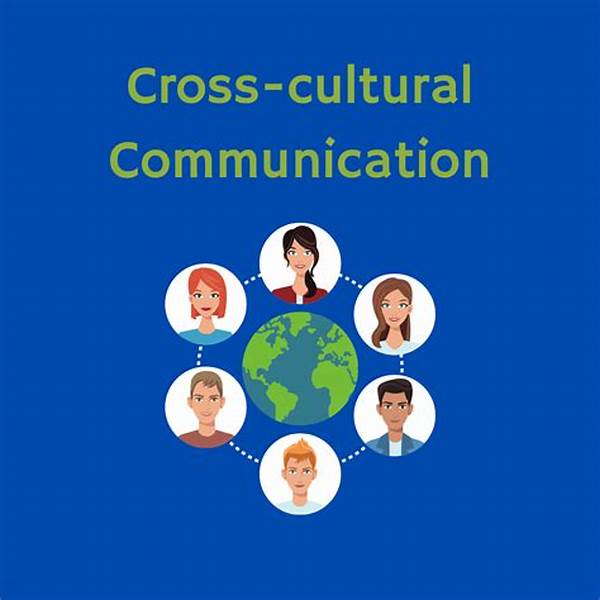Diplomacy is a dance—complex, nuanced, and often performed in a language that’s more than just words. Cross-cultural communication in diplomacy acts like an invisible thread, weaving connections and building bridges across diverse nations. As diplomats tiptoe through these conversations, every gesture, word, and nuance becomes crucial. Understanding cultures beyond our own borders isn’t just beneficial; it’s essential for preventing misunderstandings and fostering cooperation. Unearthing the treasures within cross-cultural exchanges can ultimately make or break international relations. Let’s delve into how this plays out in the diplomatic world.
Read Now : “top Japanese Pop Songs Globally”
The Role of Language in Cross-Cultural Communication in Diplomacy
Language isn’t just a tool for chatting; it’s the very bedrock upon which cross-cultural communication in diplomacy rests. When diplomats engage with counterparts from different cultures, they must navigate a maze of linguistics that goes beyond vocabulary and grammar. For instance, idioms and slang can either be bridges or barriers. Misinterpreting a phrase or underestimating cultural context can lead to diplomatic faux pas or, worse, international tensions. Moreover, mastering the art of non-verbal cues, like body language and eye contact, is crucial, as they vary significantly across cultures. It’s not just about speaking a common language—it’s about understanding the unsaid.
So, what happens when the language barrier proves too high to scale? That’s where translators step in. However, they don’t just translate words; they must capture the essence and intent behind those words to preserve the subtlety and diplomacy of conversations. Diplomatic interpreters, with their prowess in cross-cultural communication, ensure that messages remain intact and intentions are clear. Hence, language, both verbal and non-verbal, stands at the heart of effective cross-cultural communication in diplomacy.
Challenges of Cross-Cultural Communication in Diplomacy
1. Lost in Translation: Miscommunications can happen if a word or concept doesn’t have a direct equivalent in another language. Cross-cultural communication in diplomacy requires precise translation.
2. Culture Shock: Walking into an unfamiliar cultural setting can leave diplomats dizzy, trying to quickly adapt to new norms.
3. Idiomatic Expressions: Understanding local idioms and slang can make or break communication attempts.
4. Non-Verbal Cues: Crossed arms might be rude in one culture and casual in another. Knowing what’s what is key in cross-cultural communication in diplomacy.
5. High Context vs. Low Context: Some cultures rely heavily on implicit communication, while others are straightforward. Mixing these can lead to misunderstandings.
The Art of Building Relationships through Cross-Cultural Communication in Diplomacy
Ever thought diplomacy was just about politics? Think again. At its core, successful diplomacy is powered by relationships. Cross-cultural communication in diplomacy functions as the glue that holds these connections together. Picture diplomats as cultural chameleons; their ability to adapt and show empathy is what transforms foreign diplomats into trusted allies.
In diplomacy, understanding cultural practices shows respect and builds trust. For instance, participating in traditional ceremonies or learning a local greeting can enhance rapport. By appreciating these aspects, diplomats can break barriers and form substantial bonds. Through effective cross-cultural communication in diplomacy, professionals not only bridge cultural gaps but also foster mutual respect that transcends borders. Understanding and respecting cultural differences lead to smoother negotiations and stronger alliances.
Key Strategies for Effective Cross-Cultural Communication in Diplomacy
1. Active Listening: Listening involves more than just hearing words. Focus and pay full attention to the speaker.
2. Cultural Sensitivity: Being aware of cultural differences helps prevent unintentional insult or offense.
3. Adaptability: Being flexible allows a diplomat to adjust their communication style as necessary during discussions.
4. Empathy: Walk a mile in someone else’s shoes to understand their perspective better, a crucial skill for cross-cultural communication in diplomacy.
Read Now : Emerging French Musicians 2023
5. Patience: Diplomacy requires time and effort. Misunderstandings can occur; patience allows them to be addressed civilly.
6. Non-Verbal Awareness: Mastery of body language nuances is crucial for diplomatic finesse.
7. Language Proficiency: While translators bridge the gap, knowing basics show respect and effort.
8. Curiosity: Being genuinely interested in other cultures aids in relationship building.
9. Feedback Seeking: Encourage clarification and questions to ensure messages are properly received.
10. Building Common Ground: Finding shared interests promotes a friendly and open environment.
The Influence of Technology on Cross-Cultural Communication in Diplomacy
Technology has fast-tracked communication, reshaping how diplomacy is conducted. With emails, video conferences, and instant messaging, distance and cultural barriers seem less daunting. Tools like translation apps ease cross-cultural communication in diplomacy, allowing real-time translations and breaking down language barriers.
But, there’s a flip side. Misinterpretations of text-based communications can result from lack of tone and body language, potentially leading to diplomatic misunderstandings. Savvy diplomats leverage technology wisely, pairing its convenience with cultural understanding to ensure effective communication. So while tech speeds up interactions, it requires careful navigation to ensure clarity.
Summary: The Importance of Cross-Cultural Communication in Diplomacy
In a nutshell, cross-cultural communication in diplomacy is the art and science of navigating conversations and negotiations across diverse nations. It’s the unsung hero behind every successful treaty and alliance. Understanding cultural nuances, mastering languages, and displaying genuine interest in other cultures can turn strangers into allies.
Despite its challenges, fostering effective cross-cultural communication in diplomacy strengthens international ties and promotes peace. By embracing both the beauty and complexity of cultural diversity, diplomats can forge stronger alliances, leading to a more interconnected and harmonious world stage. In such a landscape, cross-cultural communication isn’t just an asset—it’s a necessity.
